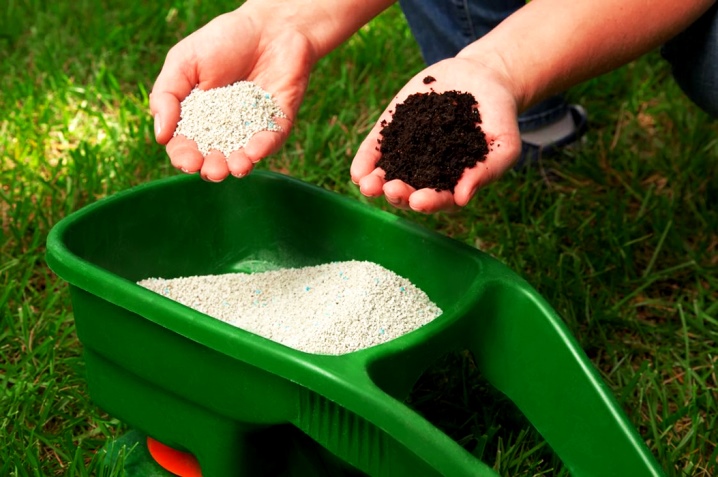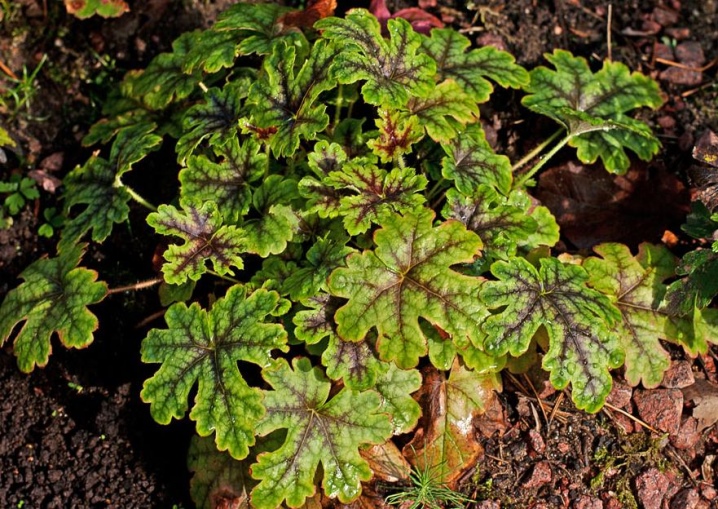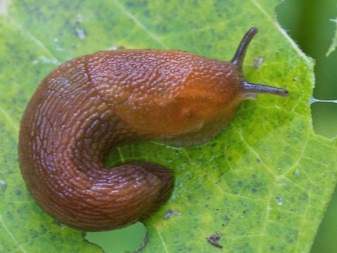Geyherella: description, varieties, agricultural technology

Geyherella is an artificially bred plant. Its creators wanted to get a spectacular decoration for landscape design. And they succeeded.
Description
Geyherella is a perennial hybrid obtained by crossing tiarella and geychera. It is an open field herb with thick superficial roots, flexible stems and decorative leaves on long petioles. The bottom of dense leaves and petioles are strewn with villi.
The decoration of the plant is its dissected foliage, the shape of which is similar to maple leaves. In the summer, some species produce small, light-colored flowers. Most of the bushes rise above the ground by no more than half a meter. The maximum height, taking into account the panicles of flowers protruding above the foliage, is 70 cm.
Designers and gardeners use the plant both for border decoration and for inclusion in floral ensembles.



Geyherella is distinguished by its unpretentiousness:
- can grow both in the sun and in shaded areas;
- does not lose the brightness of the color of the leaves until frost;
- wrapped in snow, perfectly tolerates severe frosts down to -40 degrees;
- does not fade with a short drought;
- It does not require special care;
- responsive to moderate feeding - increases in size.

Types and varieties
Geyherella has a huge number of varieties, differing in size and color of foliage. There are plants with green, red, purple and other leaf colors. Flowers in the form of bells in all varieties are small, collected in elongated inflorescences. The most popular varieties among amateur flower growers and landscape designers are as follows.
- Bridget Bloom with bright green foliage and pink-coral flowers.


- Mint frost - a silvery plant of a greenish hue.

- Buttered rum - caramel-red compact bush. The plant is no more than 30 cm in diameter, and about 15-20 cm in height. It grows well in the shade of tall trees. Changes the color of the leaves from spring red to autumn burgundy. Ideal for curbs and rockeries, it can be combined with other varieties of Heycherella, geraniums and hosts.


- Red-leaved Honey rose especially good when surrounded by ferns or other green bushes.

- Solar Eclipse (translated as "solar eclipse") appears in a rich burgundy color. At the very tips of the carved beauties, you can see a delicate light green frame.


- "Rosalie" varies somewhat during the season. In spring, the leaves are yellow-green, by the end of summer, dark greens with brown veins appear. The height of the bush is no more than 45 cm.


- At Hopscotch foliage of different colors - from green, giving off yellowness, to orange-red. And the cooler it is outside, the more purple there is in the large carved plates. White inflorescences on thin stems protrude 25-30 cm upward. Flowering is long, begins in the second half of May, ends at the end of July.

- "Golden Zebra" belongs to the category of medium-sized. Its purple-orange leaves with delicate light green edges can color dull vegetation in any weather. This is a truly magnificent plant, especially at the time of flowering, when small snow-white flowers appear.


- "Stoplight" look in their best light against the brown background of open ground. The green plates are colored with fiery red streaks.

- At Brass Lantern large leaves have a reddish-brown center and peach-colored edges.Brownish veins are cut into the lobes of the plate.

- "Tapestri" beautiful during flowering, when pale pink panicles of inflorescences appear against the background of bright greenery.

It is worth mentioning such plants as Kimono, Quick Silver, Sweet Tee, RedStoneFalls, Alabama Sunrise... Many other species of this colorful shrub are also noteworthy. All the original varieties cannot be enumerated, especially when you consider that flower growers continue their experiments, bringing out a variety of new types of ornamental plants.





Landing
The plant has retained the maternal characteristics of Heuchera. Like its progenitor, Heycherella prefers slightly alkaline and neutral soils. In addition, she does not like waterlogging. In central Russia, the bushes are planted in soil deoxidized with dolomite flour, in pits with a drainage layer of 3 to 5 centimeters. The addition of a handful of wood ash to the hole becomes a complex fertilizer. Sprinkle the roots of the seedling with loose earth. It is important to leave the central kidney open. A maximum of 12 bushes can be planted per square meter.
Although heuchera feels equally good in the sun and in partial shade, it is worth considering the preferences of a particular plant variety. For example, silvery and other leaves with a delicate color are better in illuminated areas. Bushes of green or crimson color live well in the shade.
In a large flower garden, heycherelle is convenient where it is shaded by taller plants for part of the day.



Care
It is not difficult to take care of the plant, it does not require much attention to itself, it does not take a lot of time. Dead leaves are cut off in the spring. In dry weather, you need to water the bushes. It should be remembered that excessively moist soil is harmful to heycherella. That's why when planting, you need to take care of the ebb device from the roots of rainwater... Top dressing is practically not required. Unless, at first, after planting, nitrogen fertilization can be applied.
Since the root system is shallow and periodically protrudes from the soil, it is occasionally sprinkled with humus mixed with coarse sand. Large doses of organic matter are contraindicated for the plant.
A mandatory operation is the division of the bushes every 3-4 years. That's all the simple agricultural technology. This is enough for the plant to develop well and please the eye.


Reproduction
Plant propagation is carried out in two ways:
- dividing the bush;
- by cuttings.
Seed propagation is not possible. The plant blooms but does not bear fruit. This is the case with most artificially bred varieties.


Division
The division of the bush is required to be carried out according to the rules of agricultural technology. The operation is performed once every 3-4 years. If this is not done, the bush thickens and loses its attractiveness:
- the stems are stretched;
- the tops dry out.
The best time to divide is the beginning of the third quarter of the year. It is at this time that flowering stops, and the roots begin to grow. The second half of July - early August is the most suitable period for reproduction of Heycherella. At the end of summer, there is enough time for new formations to take root before the winter cold.
At the dug out bush:
- the roots are thoroughly washed;
- cut off dried processes;
- divided into several parts, making sure that there are healthy kidneys on each part.


The distance between adjacent plantings is about 20-30 centimeters. Small parts are planted in pots, and placed in the ground already grown and strengthened.
Cuttings
For propagation by cuttings, young shoots are required. They appear in the spring. Somewhere in early April, you can already start breeding. New shoots are cut and placed in a vessel with water, flavored with root. The formation of roots will take no more than a month. After the roots appear, the plant is transferred to a pot with a nutrient mixture.
The bush is transplanted from the container into the ground after it begins to actively grow, as new leaves appear. Getting used to a new place is easy.If the planting in a permanent place was carried out shortly before the onset of cold weather, the seedling must be covered with either straw, or needles and fallen leaves, or a covering material.



Diseases and pests
Heycherella is resistant to most diseases. May be affected by such ailments as brown spot and powdery mildew. The infection is transmitted from plants that are nearby and when the root soil is waterlogged. Powdery mildew, expressed in the form of white formations on the leaves, is relieved by spraying with fungicides.
If the foliage is disfigured with brown spots, then a brown spot has appeared. As a rule, the disease causes waterlogging during prolonged rains and high air temperatures. Copper preparations are capable of overcoming it. Sometimes the bright sun causes leaf burns. This can be avoided by increasing watering in the morning or evening during the hottest weather.
Slugs feed on juicy foliage. Insects gnaw holes, leave unsightly whitish traces behind them. To scare away pests, hydrated lime is poured under the bushes. The greatest efficiency is achieved when it is scattered during insect activity - in the morning and evening hours. Eggshells are suitable from available tools. Crushed and scattered on the ground, it becomes an insurmountable obstacle for slugs on their way to the juicy "table".


Grooved weevils cause damage to the roots. Drying of the tops of the plant will indicate that insects feed on its roots. The weevil will leave the site if the ground around the bushes is sprinkled with sawdust soaked in creolin. To prepare the "medicine" you need a couple of tablespoons of creolin in a ten-liter bucket of water. Another way to get rid of weevils is mustard powder. Dissolve one tablespoon in a liter of water and spray the entire plant.


Correctly selected heykherella bushes will decorate any garden. Flower lovers are increasingly using the plant to give their plots a unique charm. Numerous types of bright foliage allow you to create the most bizarre and original compositions.
For the difference between Heychera and Heycherella, see below.







































































































The comment was sent successfully.